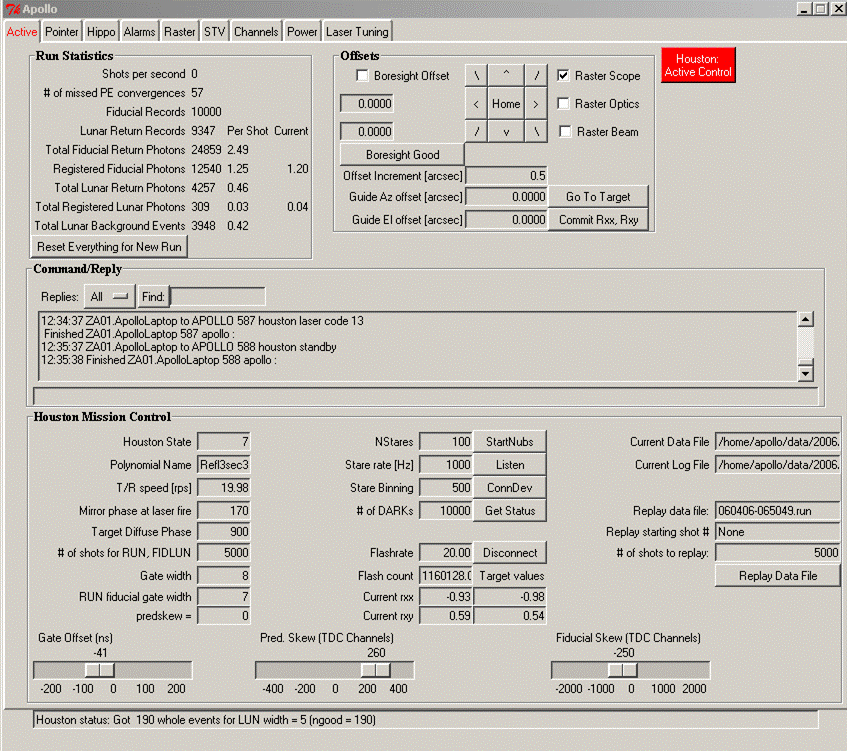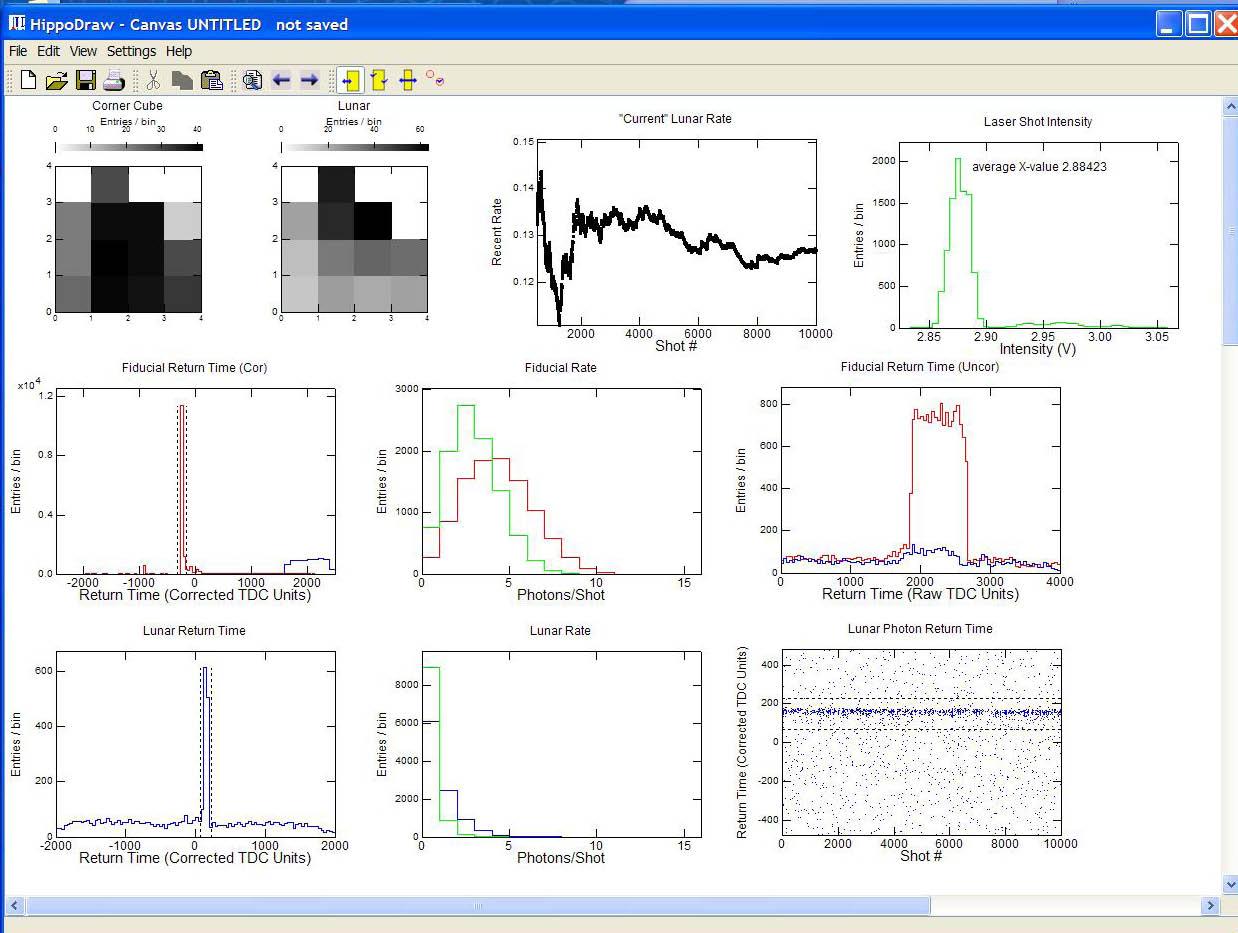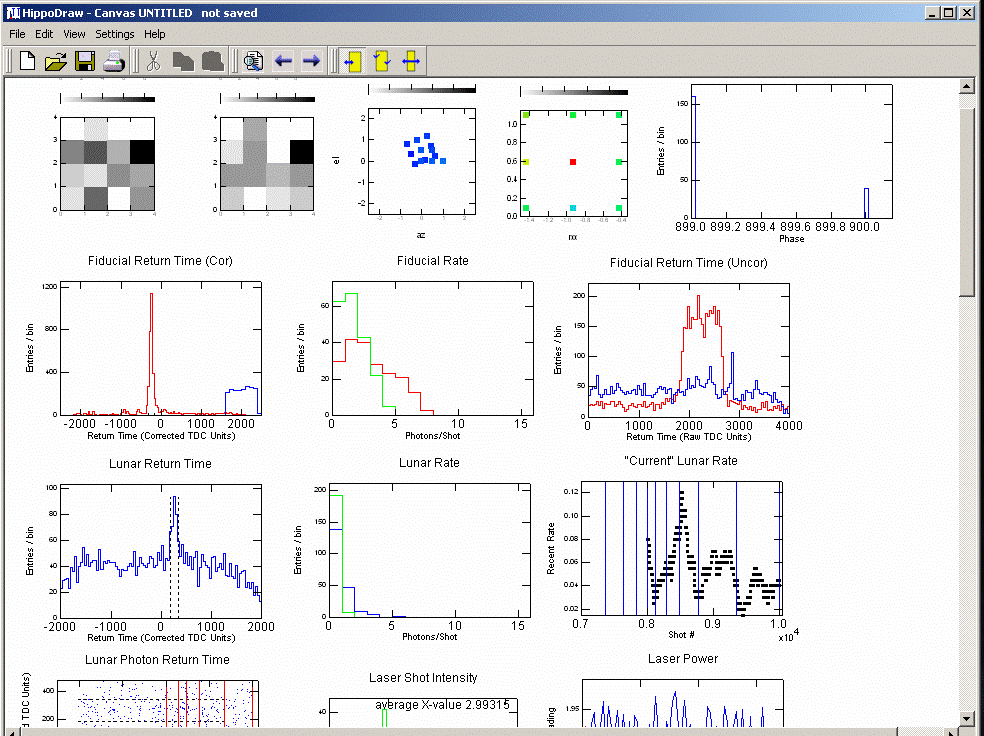The APOLLO GUI
The APOLLO graphical user interface is a highly capable platform written
in Python (by C. D. Hoyle) to interface with the Telescope User Interface
(TUI: written by Russell Owen) and the APOLLO hardware control computer,
called houston. The APOLLO GUI uses a Tk interface and employs
Hippodraw to plot the real-time data gathered by the system.
On houston runs a multi-threaded C program called
housctl (written by Eric Michelsen) that interfaces to the APOLLO
hardware and provides a command interface for human control via command
line or GUI connections.
Below is a screenshot of the the main tab of the APOLLO GUI. On this
tab we can see:
- a summary of statistics for a data run (upper left);
- a telescope offset and pointing correction panel (top center);
- a command line entry box and command response window (center);
- informational and settable parameters for controling the system state
(bottom);
- a status line at the very bottom for informational updates from
houston.

Other tabs relate to:
- a lunar pointer, modeled after the graphical
lunar pointer shown here;
- control of the data plot window parameters (axes, etc.);
- a summary of alarms: the tab turns red under a new alarm;
- control of an automated raster of telescope pointing;
- control of the APOLLO CCD (SBIG STV model);
- control over the APOLLO APD: allowing one to temporarily disable
individual channels in the 16-element array;
- power state of the roughly 20 independently activated APOLLO devices;
- laser state control, power measurement, tuning.
An example of the graphical window is shown below. This is a
moderate-strength run on the Apollo 11 reflector.

The plots, starting at upper left, depict:
- the pattern reflected by the last 40 fiducial (local corner cube) return photons on the
4×4 APD array
- the pattern of the last 40 lunar return photons on the array (see concentration of returned light near the top, suggesting a telescope nudge)
- stripchart of lunar return rate, seen here peaking at about 0.12
photons per pulse
- laser pulse energy (shot-by-shot) monitor
- the fiducial return (red) from the local corner cube, together with the
distribution of fast-photodiode returns (blue: should be 800 bins wide around
2000)
- the rate of fiducial returns: red = all returns, including background;
green = "registered" fiducials—those in the spike
- raw fiducial (red) and lunar (blue) returns in TDC units (1 unit = 25 ps)
- lunar return histogram: the reflector return is seen above the
background (from bright moon, mostly)
- lunar photon rate: blue = all returns; green = "registered"
lunars (within dashed-bar window)—most get zero, and a few get 1
photon, and there are a few shots with more than one return photon
- stripchart showing all photon events; real lunar events fit
within dashed region, and tend to cluster
Another Example Screen
This was not a
particularly impressive run (poor atmospheric conditions), but it does show
a signal return from the Apollo 15 reflector.

The plots, starting at upper left, depict:
- the pattern reflected by the last 40 fiducial (local corner cube) return photons on the
4×4 APD array
- the pattern of the last 40 lunar return photons on the array
- the pattern of telescope offsets pursued in the run
- the pattern of transmit/receive beam offset during the run; the color
indicates lunar return rate—the best spot is in the middle
- the relative phase between T/R optic and diffuser optic
- the fiducial return (red) from the local corner cube, together with the
distribution of fast-photodiode returns (blue: should be 800 bins wide around
2000)
- the rate of fiducial returns: red = all returns, including background;
green = "registered" fiducials—those in the spike
- raw fiducial (red) and lunar (blue) returns in TDC units (1 unit = 25 ps)
- lunar return histogram: the reflector return is seen above the
background (from bright moon, mostly)
- lunar photon rate: blue = all returns; green = "registered"
lunars (within dashed-bar window)—most get zero, and a few get 1
photon (in this crummy run)
- stripchart of lunar return rate, seen here peaking at about 0.12
photons per pulse
- (top of) stripchart showing all photon events; real lunar events fit
within dashed region, and tend to cluster
- (top of) laser pulse energy (shot-by-shot) monitor
- (top of) laser power measurement monitor (performed occasionally)
There are a few more plot windows that are not shown here, but this gets
at the core. Others relate to a "stare" mode, wherein we point
the telescope at a star or at the moon, and record the flux (as a function
of time and of position on the detector array).
APOLLO Main Page

